Dissertation: Left Atrial Appendage Closure for Stroke Prevention
VerifiedAdded on 2023/06/07
|40
|14160
|437
Project
AI Summary
This dissertation investigates the efficacy of left atrial appendage closure (LAAC) for stroke prevention in patients with atrial fibrillation. It explores the background of strokes, their causes, and the rationale for LAAC as a preventative measure, including a detailed literature review and meta-analysis of relevant studies. The methodology includes eligibility criteria, information sources, study screening, quality assessment, and data extraction. The results section presents findings, including PRISMA flowcharts, quality assessments, and data extraction tables. The discussion section analyzes the risk of bias, summarizes findings, and compares the Amplatzer and Watchman devices. The study also considers limitations and future research implications. The conclusion summarizes the key findings and provides recommendations based on the research.

Left atrial appendage closure for
prevention of stroke
prevention of stroke
Paraphrase This Document
Need a fresh take? Get an instant paraphrase of this document with our AI Paraphraser
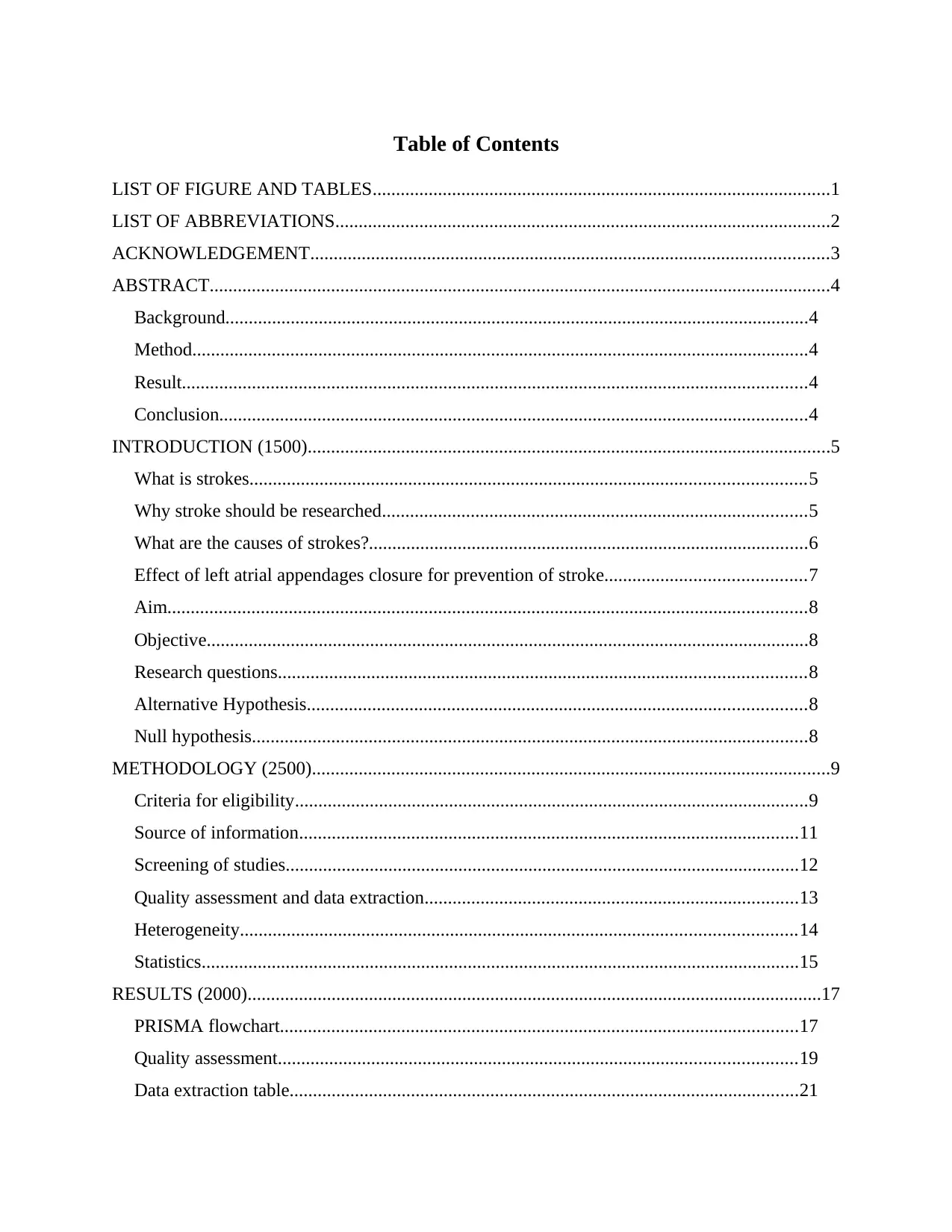
Table of Contents
LIST OF FIGURE AND TABLES..................................................................................................1
LIST OF ABBREVIATIONS..........................................................................................................2
ACKNOWLEDGEMENT...............................................................................................................3
ABSTRACT.....................................................................................................................................4
Background.............................................................................................................................4
Method....................................................................................................................................4
Result......................................................................................................................................4
Conclusion..............................................................................................................................4
INTRODUCTION (1500)................................................................................................................5
What is strokes.......................................................................................................................5
Why stroke should be researched...........................................................................................5
What are the causes of strokes?..............................................................................................6
Effect of left atrial appendages closure for prevention of stroke...........................................7
Aim.........................................................................................................................................8
Objective.................................................................................................................................8
Research questions.................................................................................................................8
Alternative Hypothesis...........................................................................................................8
Null hypothesis.......................................................................................................................8
METHODOLOGY (2500)...............................................................................................................9
Criteria for eligibility..............................................................................................................9
Source of information...........................................................................................................11
Screening of studies..............................................................................................................12
Quality assessment and data extraction................................................................................13
Heterogeneity.......................................................................................................................14
Statistics................................................................................................................................15
RESULTS (2000)...........................................................................................................................17
PRISMA flowchart...............................................................................................................17
Quality assessment...............................................................................................................19
Data extraction table.............................................................................................................21
LIST OF FIGURE AND TABLES..................................................................................................1
LIST OF ABBREVIATIONS..........................................................................................................2
ACKNOWLEDGEMENT...............................................................................................................3
ABSTRACT.....................................................................................................................................4
Background.............................................................................................................................4
Method....................................................................................................................................4
Result......................................................................................................................................4
Conclusion..............................................................................................................................4
INTRODUCTION (1500)................................................................................................................5
What is strokes.......................................................................................................................5
Why stroke should be researched...........................................................................................5
What are the causes of strokes?..............................................................................................6
Effect of left atrial appendages closure for prevention of stroke...........................................7
Aim.........................................................................................................................................8
Objective.................................................................................................................................8
Research questions.................................................................................................................8
Alternative Hypothesis...........................................................................................................8
Null hypothesis.......................................................................................................................8
METHODOLOGY (2500)...............................................................................................................9
Criteria for eligibility..............................................................................................................9
Source of information...........................................................................................................11
Screening of studies..............................................................................................................12
Quality assessment and data extraction................................................................................13
Heterogeneity.......................................................................................................................14
Statistics................................................................................................................................15
RESULTS (2000)...........................................................................................................................17
PRISMA flowchart...............................................................................................................17
Quality assessment...............................................................................................................19
Data extraction table.............................................................................................................21
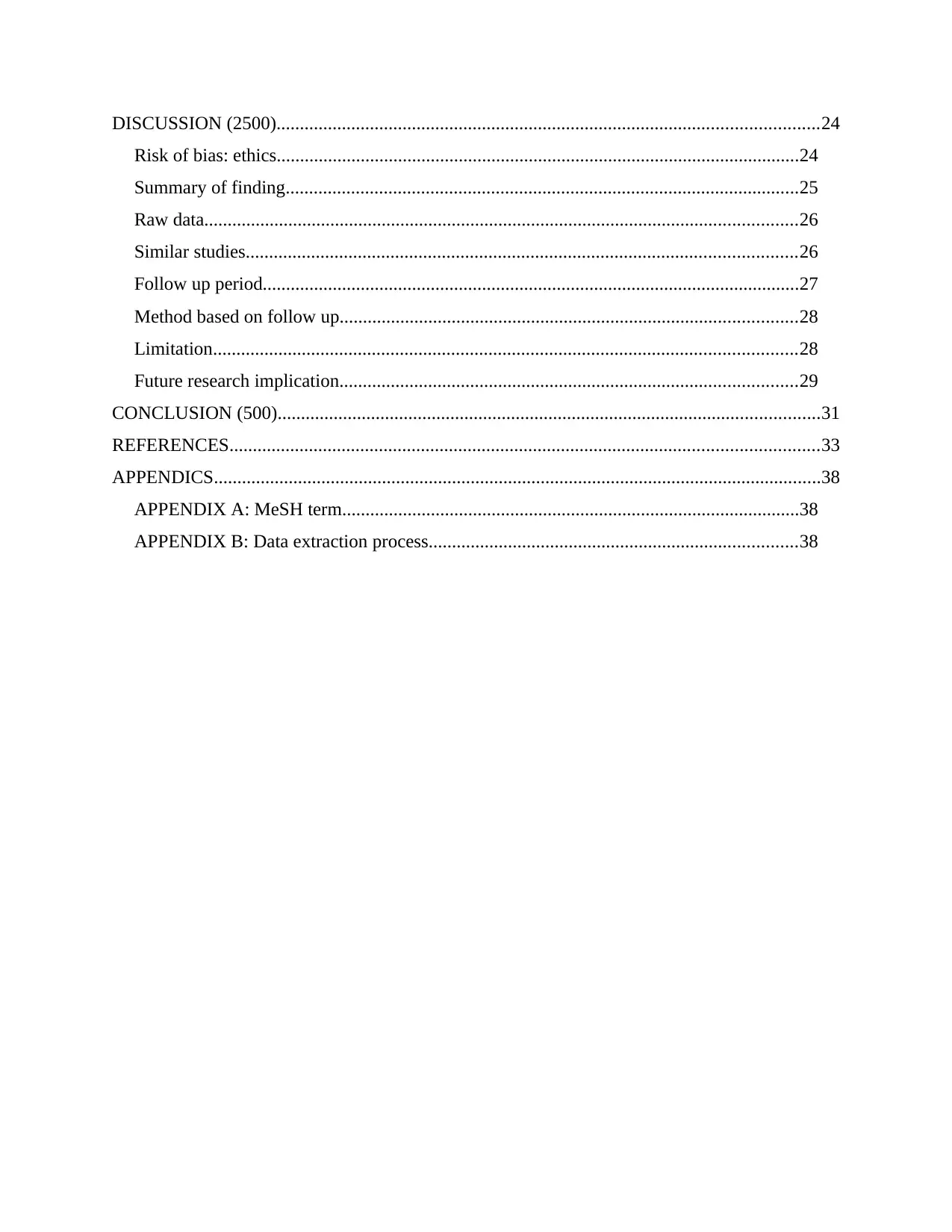
DISCUSSION (2500)....................................................................................................................24
Risk of bias: ethics................................................................................................................24
Summary of finding..............................................................................................................25
Raw data...............................................................................................................................26
Similar studies......................................................................................................................26
Follow up period...................................................................................................................27
Method based on follow up..................................................................................................28
Limitation.............................................................................................................................28
Future research implication..................................................................................................29
CONCLUSION (500)....................................................................................................................31
REFERENCES..............................................................................................................................33
APPENDICS..................................................................................................................................38
APPENDIX A: MeSH term..................................................................................................38
APPENDIX B: Data extraction process...............................................................................38
Risk of bias: ethics................................................................................................................24
Summary of finding..............................................................................................................25
Raw data...............................................................................................................................26
Similar studies......................................................................................................................26
Follow up period...................................................................................................................27
Method based on follow up..................................................................................................28
Limitation.............................................................................................................................28
Future research implication..................................................................................................29
CONCLUSION (500)....................................................................................................................31
REFERENCES..............................................................................................................................33
APPENDICS..................................................................................................................................38
APPENDIX A: MeSH term..................................................................................................38
APPENDIX B: Data extraction process...............................................................................38
⊘ This is a preview!⊘
Do you want full access?
Subscribe today to unlock all pages.

Trusted by 1+ million students worldwide
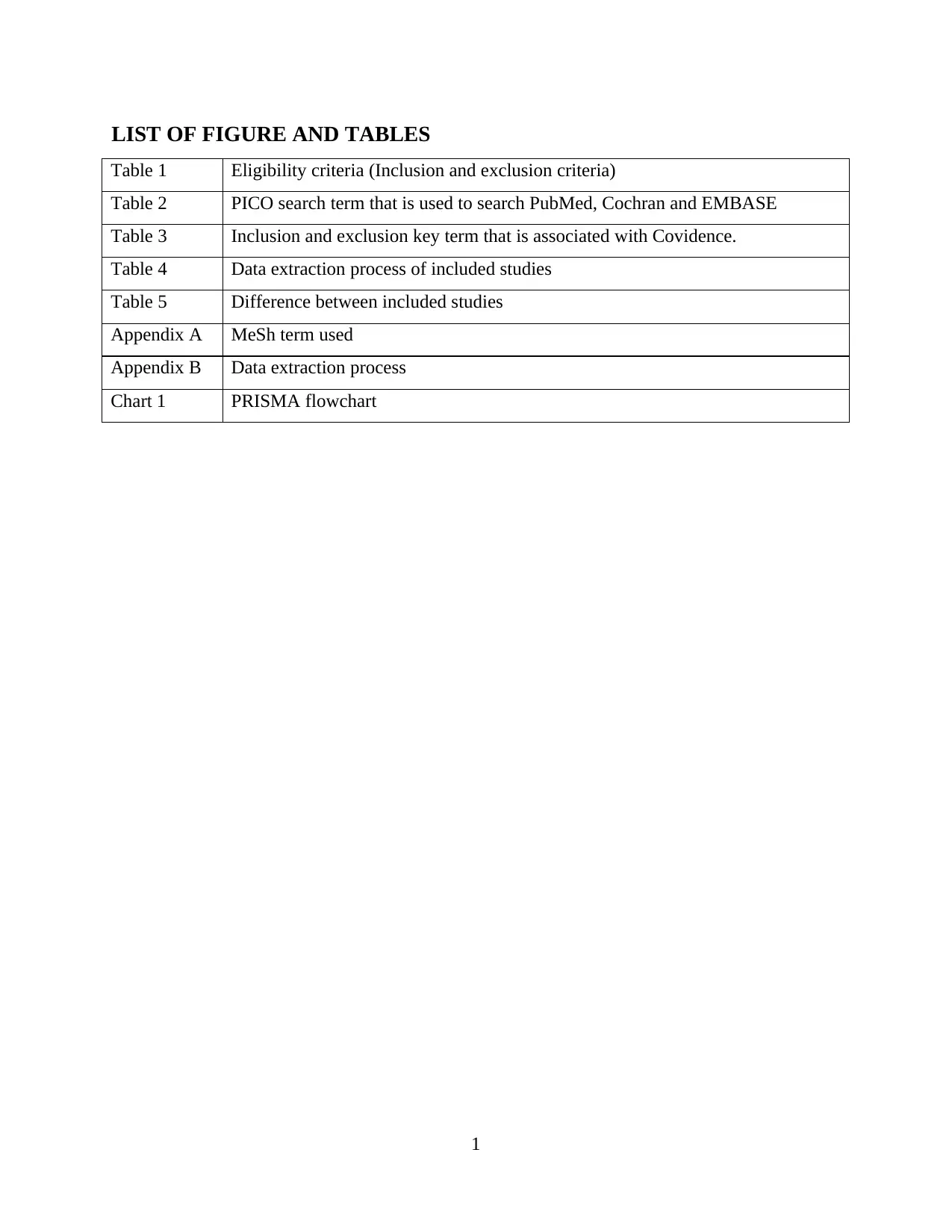
LIST OF FIGURE AND TABLES
Table 1 Eligibility criteria (Inclusion and exclusion criteria)
Table 2 PICO search term that is used to search PubMed, Cochran and EMBASE
Table 3 Inclusion and exclusion key term that is associated with Covidence.
Table 4 Data extraction process of included studies
Table 5 Difference between included studies
Appendix A MeSh term used
Appendix B Data extraction process
Chart 1 PRISMA flowchart
1
Table 1 Eligibility criteria (Inclusion and exclusion criteria)
Table 2 PICO search term that is used to search PubMed, Cochran and EMBASE
Table 3 Inclusion and exclusion key term that is associated with Covidence.
Table 4 Data extraction process of included studies
Table 5 Difference between included studies
Appendix A MeSh term used
Appendix B Data extraction process
Chart 1 PRISMA flowchart
1
Paraphrase This Document
Need a fresh take? Get an instant paraphrase of this document with our AI Paraphraser
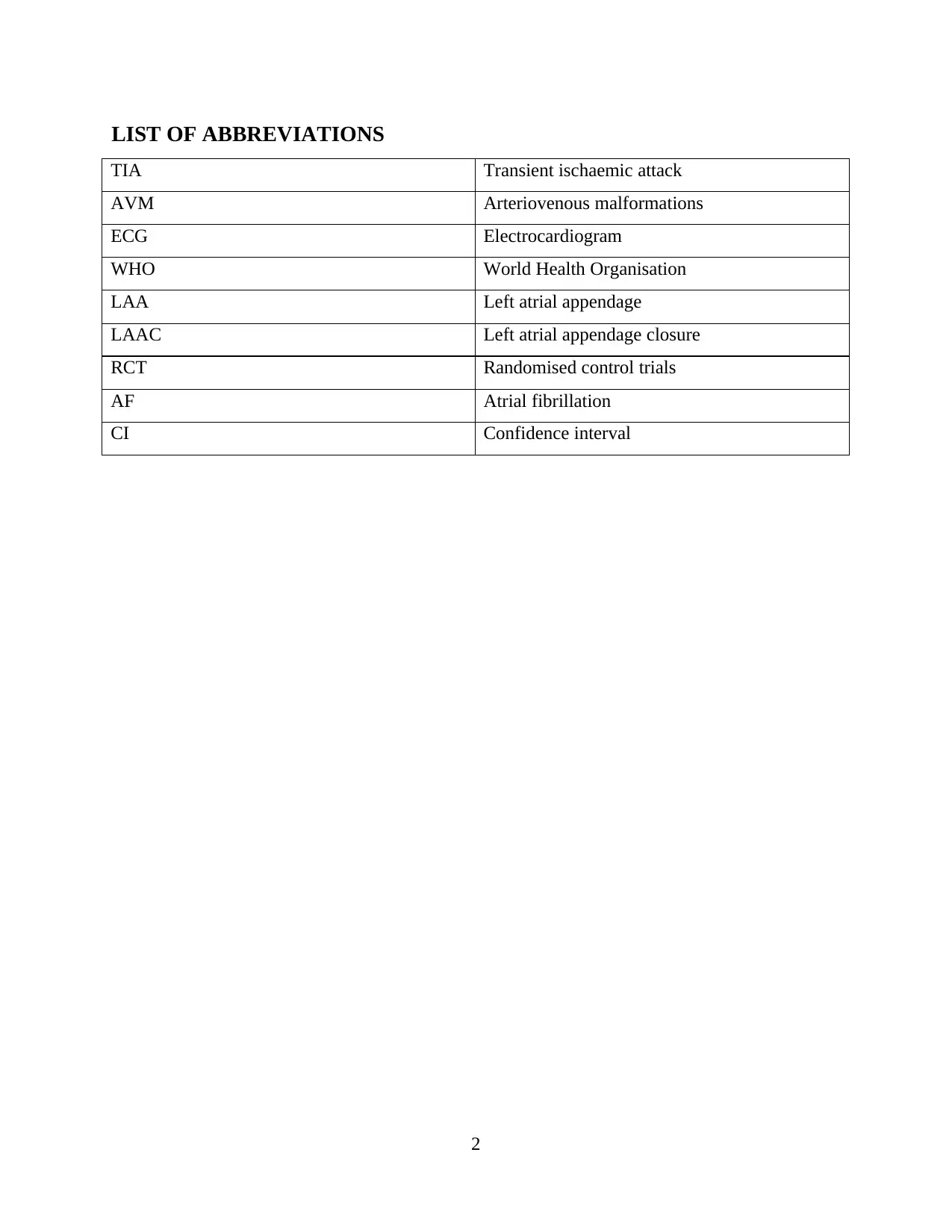
LIST OF ABBREVIATIONS
TIA Transient ischaemic attack
AVM Arteriovenous malformations
ECG Electrocardiogram
WHO World Health Organisation
LAA Left atrial appendage
LAAC Left atrial appendage closure
RCT Randomised control trials
AF Atrial fibrillation
CI Confidence interval
2
TIA Transient ischaemic attack
AVM Arteriovenous malformations
ECG Electrocardiogram
WHO World Health Organisation
LAA Left atrial appendage
LAAC Left atrial appendage closure
RCT Randomised control trials
AF Atrial fibrillation
CI Confidence interval
2

ACKNOWLEDGEMENT
I would like to express my special thanks of gratitude to my teacher …… who gave me such
golden opportunity to do project that is related with investigation of Left atrial appendage closure
for prevention of stroke.
While conducting the research on title, I came to know about various of thing that I never
achieved without support to teacher and family. Secondly, I would also like to thank my parents
and friends who help me a lot of finalising this project within the limited time frame.
3
I would like to express my special thanks of gratitude to my teacher …… who gave me such
golden opportunity to do project that is related with investigation of Left atrial appendage closure
for prevention of stroke.
While conducting the research on title, I came to know about various of thing that I never
achieved without support to teacher and family. Secondly, I would also like to thank my parents
and friends who help me a lot of finalising this project within the limited time frame.
3
⊘ This is a preview!⊘
Do you want full access?
Subscribe today to unlock all pages.

Trusted by 1+ million students worldwide
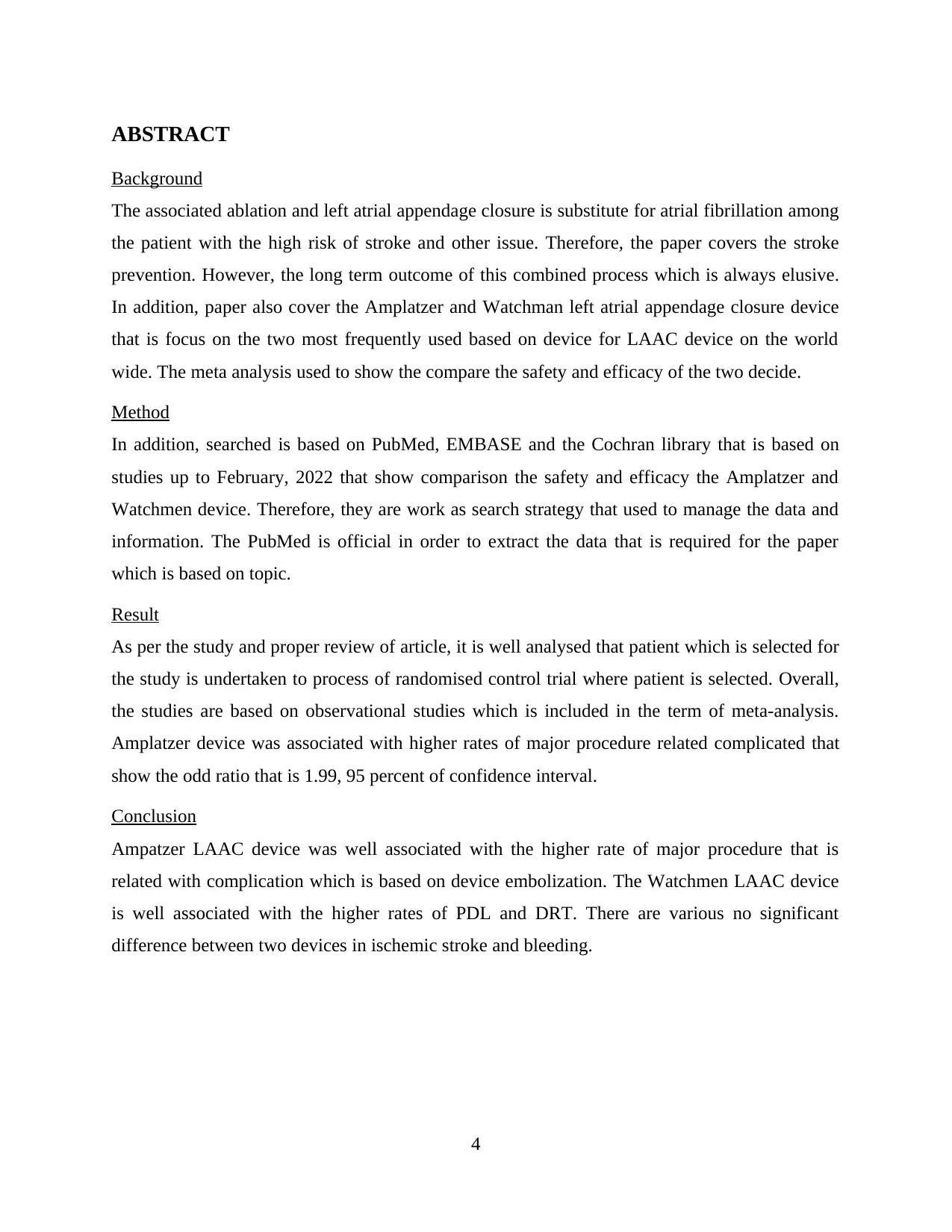
ABSTRACT
Background
The associated ablation and left atrial appendage closure is substitute for atrial fibrillation among
the patient with the high risk of stroke and other issue. Therefore, the paper covers the stroke
prevention. However, the long term outcome of this combined process which is always elusive.
In addition, paper also cover the Amplatzer and Watchman left atrial appendage closure device
that is focus on the two most frequently used based on device for LAAC device on the world
wide. The meta analysis used to show the compare the safety and efficacy of the two decide.
Method
In addition, searched is based on PubMed, EMBASE and the Cochran library that is based on
studies up to February, 2022 that show comparison the safety and efficacy the Amplatzer and
Watchmen device. Therefore, they are work as search strategy that used to manage the data and
information. The PubMed is official in order to extract the data that is required for the paper
which is based on topic.
Result
As per the study and proper review of article, it is well analysed that patient which is selected for
the study is undertaken to process of randomised control trial where patient is selected. Overall,
the studies are based on observational studies which is included in the term of meta-analysis.
Amplatzer device was associated with higher rates of major procedure related complicated that
show the odd ratio that is 1.99, 95 percent of confidence interval.
Conclusion
Ampatzer LAAC device was well associated with the higher rate of major procedure that is
related with complication which is based on device embolization. The Watchmen LAAC device
is well associated with the higher rates of PDL and DRT. There are various no significant
difference between two devices in ischemic stroke and bleeding.
4
Background
The associated ablation and left atrial appendage closure is substitute for atrial fibrillation among
the patient with the high risk of stroke and other issue. Therefore, the paper covers the stroke
prevention. However, the long term outcome of this combined process which is always elusive.
In addition, paper also cover the Amplatzer and Watchman left atrial appendage closure device
that is focus on the two most frequently used based on device for LAAC device on the world
wide. The meta analysis used to show the compare the safety and efficacy of the two decide.
Method
In addition, searched is based on PubMed, EMBASE and the Cochran library that is based on
studies up to February, 2022 that show comparison the safety and efficacy the Amplatzer and
Watchmen device. Therefore, they are work as search strategy that used to manage the data and
information. The PubMed is official in order to extract the data that is required for the paper
which is based on topic.
Result
As per the study and proper review of article, it is well analysed that patient which is selected for
the study is undertaken to process of randomised control trial where patient is selected. Overall,
the studies are based on observational studies which is included in the term of meta-analysis.
Amplatzer device was associated with higher rates of major procedure related complicated that
show the odd ratio that is 1.99, 95 percent of confidence interval.
Conclusion
Ampatzer LAAC device was well associated with the higher rate of major procedure that is
related with complication which is based on device embolization. The Watchmen LAAC device
is well associated with the higher rates of PDL and DRT. There are various no significant
difference between two devices in ischemic stroke and bleeding.
4
Paraphrase This Document
Need a fresh take? Get an instant paraphrase of this document with our AI Paraphraser

INTRODUCTION
What is strokes
A stroke can be characterised as one of the serious life threatening medical circumstances
that occurs when anything obstructs blood supply to the cells of brain or when a blood vessel
bursts in the brain. A stroke can cause long term disability, brain damage and even death.
According to the perspective of James (2020), there are basically three main types of stroke
(Alfadhel, and et. al., 2021). They stated these were ischaemic stroke; in this blood clots create
disturbance in blood and oxygen from reaching a region of the brain, haemorrhagic stroke; it
occurs due to rapture blood vessels and these stroke are usually outcome of arteriovenous
malformations (AVMs) or aneurysms, Transient ischaemic attack (TIA); a type of mini stroke
due to inadequate blood flow to brain. Charles (2022) suggests that atrial fibrillation, heart valve
disease and patent foramen ovale can be the effective cause of stroke. Morgan & Claypool
(2010) specified that there are four major arteries in human body, which supply the brain with
blood. That arteries are left and right carotid arteries are found in the front side of the neck and
by the assist of fingers their pulse can be felt. The left and right vertebral arteries are enlaced in
the bone as they run in the neck through vertebrae. When fibrillation and obstruction occurs due
to any circumstances in these arteries then it causes blockage to brain flow with blood. It can be
recognised by an electrocardiogram (ECG) having irregular interval between QRS complexes
and no P wave (Cruz-Gonzalez, and et. al., 2018).
Why stroke should be researched
As per the report of world health organisation (WHO), stroke can be upcoming pandemic
in future. According to Anita et. Al (2017), it was determined that at least “£48 million” was
spent per stroke patient. It was also evaluated that the whole spending could increase to 10%
from 0.7% over the next 10 to 12 years. With the heavy disbursement on treatable situations such
as stroke, this is becoming progressively harder to fund too vital areas of the NHS that need aid.
Raphael Wittenberg states (2015) states that annual National health safety cost of strokes could
enhance to £10.2 billion in 2035 from £3.4 in 2015. As per the perspective of Anita (2017), the
estimated yearly number of the stroke cases ranges from 113400 – 119100 in United Kingdom.
Derek king et. al. (2017) estimates that by 2035, approximately 187,000 human being may have
stroke in United Kingdom alone (Ibrahim, and et. al., 2019). The other main reason which is also
5
What is strokes
A stroke can be characterised as one of the serious life threatening medical circumstances
that occurs when anything obstructs blood supply to the cells of brain or when a blood vessel
bursts in the brain. A stroke can cause long term disability, brain damage and even death.
According to the perspective of James (2020), there are basically three main types of stroke
(Alfadhel, and et. al., 2021). They stated these were ischaemic stroke; in this blood clots create
disturbance in blood and oxygen from reaching a region of the brain, haemorrhagic stroke; it
occurs due to rapture blood vessels and these stroke are usually outcome of arteriovenous
malformations (AVMs) or aneurysms, Transient ischaemic attack (TIA); a type of mini stroke
due to inadequate blood flow to brain. Charles (2022) suggests that atrial fibrillation, heart valve
disease and patent foramen ovale can be the effective cause of stroke. Morgan & Claypool
(2010) specified that there are four major arteries in human body, which supply the brain with
blood. That arteries are left and right carotid arteries are found in the front side of the neck and
by the assist of fingers their pulse can be felt. The left and right vertebral arteries are enlaced in
the bone as they run in the neck through vertebrae. When fibrillation and obstruction occurs due
to any circumstances in these arteries then it causes blockage to brain flow with blood. It can be
recognised by an electrocardiogram (ECG) having irregular interval between QRS complexes
and no P wave (Cruz-Gonzalez, and et. al., 2018).
Why stroke should be researched
As per the report of world health organisation (WHO), stroke can be upcoming pandemic
in future. According to Anita et. Al (2017), it was determined that at least “£48 million” was
spent per stroke patient. It was also evaluated that the whole spending could increase to 10%
from 0.7% over the next 10 to 12 years. With the heavy disbursement on treatable situations such
as stroke, this is becoming progressively harder to fund too vital areas of the NHS that need aid.
Raphael Wittenberg states (2015) states that annual National health safety cost of strokes could
enhance to £10.2 billion in 2035 from £3.4 in 2015. As per the perspective of Anita (2017), the
estimated yearly number of the stroke cases ranges from 113400 – 119100 in United Kingdom.
Derek king et. al. (2017) estimates that by 2035, approximately 187,000 human being may have
stroke in United Kingdom alone (Ibrahim, and et. al., 2019). The other main reason which is also
5
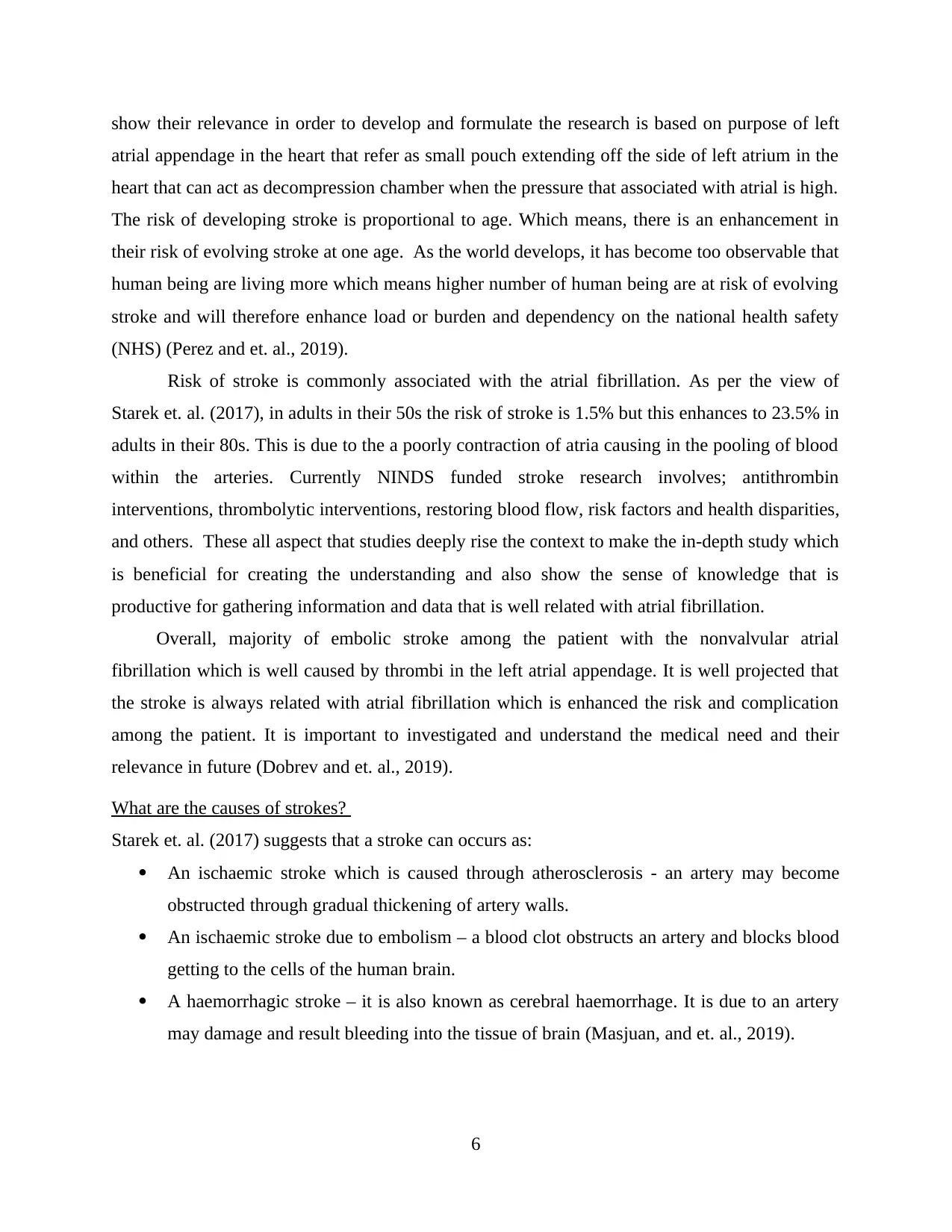
show their relevance in order to develop and formulate the research is based on purpose of left
atrial appendage in the heart that refer as small pouch extending off the side of left atrium in the
heart that can act as decompression chamber when the pressure that associated with atrial is high.
The risk of developing stroke is proportional to age. Which means, there is an enhancement in
their risk of evolving stroke at one age. As the world develops, it has become too observable that
human being are living more which means higher number of human being are at risk of evolving
stroke and will therefore enhance load or burden and dependency on the national health safety
(NHS) (Perez and et. al., 2019).
Risk of stroke is commonly associated with the atrial fibrillation. As per the view of
Starek et. al. (2017), in adults in their 50s the risk of stroke is 1.5% but this enhances to 23.5% in
adults in their 80s. This is due to the a poorly contraction of atria causing in the pooling of blood
within the arteries. Currently NINDS funded stroke research involves; antithrombin
interventions, thrombolytic interventions, restoring blood flow, risk factors and health disparities,
and others. These all aspect that studies deeply rise the context to make the in-depth study which
is beneficial for creating the understanding and also show the sense of knowledge that is
productive for gathering information and data that is well related with atrial fibrillation.
Overall, majority of embolic stroke among the patient with the nonvalvular atrial
fibrillation which is well caused by thrombi in the left atrial appendage. It is well projected that
the stroke is always related with atrial fibrillation which is enhanced the risk and complication
among the patient. It is important to investigated and understand the medical need and their
relevance in future (Dobrev and et. al., 2019).
What are the causes of strokes?
Starek et. al. (2017) suggests that a stroke can occurs as:
An ischaemic stroke which is caused through atherosclerosis - an artery may become
obstructed through gradual thickening of artery walls.
An ischaemic stroke due to embolism – a blood clot obstructs an artery and blocks blood
getting to the cells of the human brain.
A haemorrhagic stroke – it is also known as cerebral haemorrhage. It is due to an artery
may damage and result bleeding into the tissue of brain (Masjuan, and et. al., 2019).
6
atrial appendage in the heart that refer as small pouch extending off the side of left atrium in the
heart that can act as decompression chamber when the pressure that associated with atrial is high.
The risk of developing stroke is proportional to age. Which means, there is an enhancement in
their risk of evolving stroke at one age. As the world develops, it has become too observable that
human being are living more which means higher number of human being are at risk of evolving
stroke and will therefore enhance load or burden and dependency on the national health safety
(NHS) (Perez and et. al., 2019).
Risk of stroke is commonly associated with the atrial fibrillation. As per the view of
Starek et. al. (2017), in adults in their 50s the risk of stroke is 1.5% but this enhances to 23.5% in
adults in their 80s. This is due to the a poorly contraction of atria causing in the pooling of blood
within the arteries. Currently NINDS funded stroke research involves; antithrombin
interventions, thrombolytic interventions, restoring blood flow, risk factors and health disparities,
and others. These all aspect that studies deeply rise the context to make the in-depth study which
is beneficial for creating the understanding and also show the sense of knowledge that is
productive for gathering information and data that is well related with atrial fibrillation.
Overall, majority of embolic stroke among the patient with the nonvalvular atrial
fibrillation which is well caused by thrombi in the left atrial appendage. It is well projected that
the stroke is always related with atrial fibrillation which is enhanced the risk and complication
among the patient. It is important to investigated and understand the medical need and their
relevance in future (Dobrev and et. al., 2019).
What are the causes of strokes?
Starek et. al. (2017) suggests that a stroke can occurs as:
An ischaemic stroke which is caused through atherosclerosis - an artery may become
obstructed through gradual thickening of artery walls.
An ischaemic stroke due to embolism – a blood clot obstructs an artery and blocks blood
getting to the cells of the human brain.
A haemorrhagic stroke – it is also known as cerebral haemorrhage. It is due to an artery
may damage and result bleeding into the tissue of brain (Masjuan, and et. al., 2019).
6
⊘ This is a preview!⊘
Do you want full access?
Subscribe today to unlock all pages.

Trusted by 1+ million students worldwide
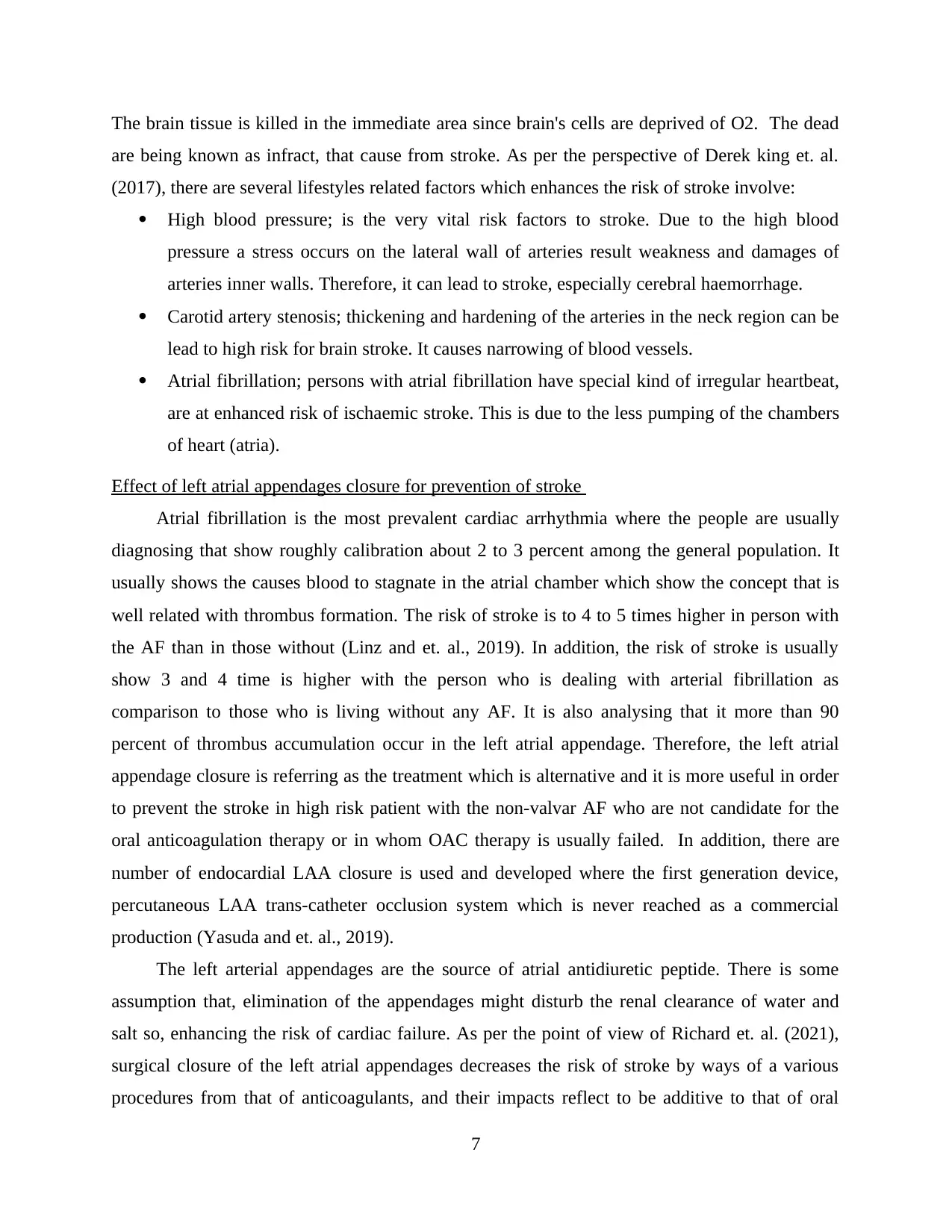
The brain tissue is killed in the immediate area since brain's cells are deprived of O2. The dead
are being known as infract, that cause from stroke. As per the perspective of Derek king et. al.
(2017), there are several lifestyles related factors which enhances the risk of stroke involve:
High blood pressure; is the very vital risk factors to stroke. Due to the high blood
pressure a stress occurs on the lateral wall of arteries result weakness and damages of
arteries inner walls. Therefore, it can lead to stroke, especially cerebral haemorrhage.
Carotid artery stenosis; thickening and hardening of the arteries in the neck region can be
lead to high risk for brain stroke. It causes narrowing of blood vessels.
Atrial fibrillation; persons with atrial fibrillation have special kind of irregular heartbeat,
are at enhanced risk of ischaemic stroke. This is due to the less pumping of the chambers
of heart (atria).
Effect of left atrial appendages closure for prevention of stroke
Atrial fibrillation is the most prevalent cardiac arrhythmia where the people are usually
diagnosing that show roughly calibration about 2 to 3 percent among the general population. It
usually shows the causes blood to stagnate in the atrial chamber which show the concept that is
well related with thrombus formation. The risk of stroke is to 4 to 5 times higher in person with
the AF than in those without (Linz and et. al., 2019). In addition, the risk of stroke is usually
show 3 and 4 time is higher with the person who is dealing with arterial fibrillation as
comparison to those who is living without any AF. It is also analysing that it more than 90
percent of thrombus accumulation occur in the left atrial appendage. Therefore, the left atrial
appendage closure is referring as the treatment which is alternative and it is more useful in order
to prevent the stroke in high risk patient with the non-valvar AF who are not candidate for the
oral anticoagulation therapy or in whom OAC therapy is usually failed. In addition, there are
number of endocardial LAA closure is used and developed where the first generation device,
percutaneous LAA trans-catheter occlusion system which is never reached as a commercial
production (Yasuda and et. al., 2019).
The left arterial appendages are the source of atrial antidiuretic peptide. There is some
assumption that, elimination of the appendages might disturb the renal clearance of water and
salt so, enhancing the risk of cardiac failure. As per the point of view of Richard et. al. (2021),
surgical closure of the left atrial appendages decreases the risk of stroke by ways of a various
procedures from that of anticoagulants, and their impacts reflect to be additive to that of oral
7
are being known as infract, that cause from stroke. As per the perspective of Derek king et. al.
(2017), there are several lifestyles related factors which enhances the risk of stroke involve:
High blood pressure; is the very vital risk factors to stroke. Due to the high blood
pressure a stress occurs on the lateral wall of arteries result weakness and damages of
arteries inner walls. Therefore, it can lead to stroke, especially cerebral haemorrhage.
Carotid artery stenosis; thickening and hardening of the arteries in the neck region can be
lead to high risk for brain stroke. It causes narrowing of blood vessels.
Atrial fibrillation; persons with atrial fibrillation have special kind of irregular heartbeat,
are at enhanced risk of ischaemic stroke. This is due to the less pumping of the chambers
of heart (atria).
Effect of left atrial appendages closure for prevention of stroke
Atrial fibrillation is the most prevalent cardiac arrhythmia where the people are usually
diagnosing that show roughly calibration about 2 to 3 percent among the general population. It
usually shows the causes blood to stagnate in the atrial chamber which show the concept that is
well related with thrombus formation. The risk of stroke is to 4 to 5 times higher in person with
the AF than in those without (Linz and et. al., 2019). In addition, the risk of stroke is usually
show 3 and 4 time is higher with the person who is dealing with arterial fibrillation as
comparison to those who is living without any AF. It is also analysing that it more than 90
percent of thrombus accumulation occur in the left atrial appendage. Therefore, the left atrial
appendage closure is referring as the treatment which is alternative and it is more useful in order
to prevent the stroke in high risk patient with the non-valvar AF who are not candidate for the
oral anticoagulation therapy or in whom OAC therapy is usually failed. In addition, there are
number of endocardial LAA closure is used and developed where the first generation device,
percutaneous LAA trans-catheter occlusion system which is never reached as a commercial
production (Yasuda and et. al., 2019).
The left arterial appendages are the source of atrial antidiuretic peptide. There is some
assumption that, elimination of the appendages might disturb the renal clearance of water and
salt so, enhancing the risk of cardiac failure. As per the point of view of Richard et. al. (2021),
surgical closure of the left atrial appendages decreases the risk of stroke by ways of a various
procedures from that of anticoagulants, and their impacts reflect to be additive to that of oral
7
Paraphrase This Document
Need a fresh take? Get an instant paraphrase of this document with our AI Paraphraser
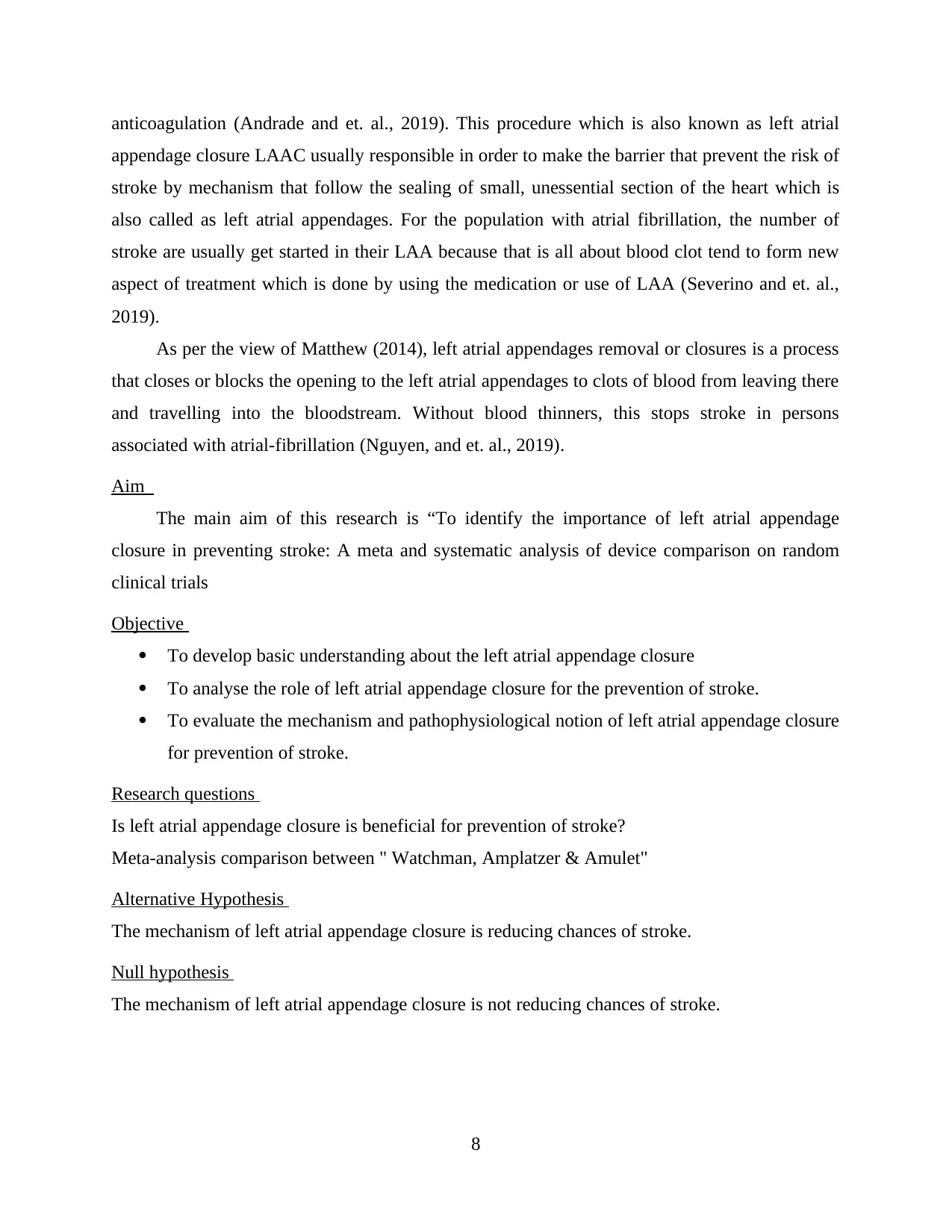
anticoagulation (Andrade and et. al., 2019). This procedure which is also known as left atrial
appendage closure LAAC usually responsible in order to make the barrier that prevent the risk of
stroke by mechanism that follow the sealing of small, unessential section of the heart which is
also called as left atrial appendages. For the population with atrial fibrillation, the number of
stroke are usually get started in their LAA because that is all about blood clot tend to form new
aspect of treatment which is done by using the medication or use of LAA (Severino and et. al.,
2019).
As per the view of Matthew (2014), left atrial appendages removal or closures is a process
that closes or blocks the opening to the left atrial appendages to clots of blood from leaving there
and travelling into the bloodstream. Without blood thinners, this stops stroke in persons
associated with atrial-fibrillation (Nguyen, and et. al., 2019).
Aim
The main aim of this research is “To identify the importance of left atrial appendage
closure in preventing stroke: A meta and systematic analysis of device comparison on random
clinical trials
Objective
To develop basic understanding about the left atrial appendage closure
To analyse the role of left atrial appendage closure for the prevention of stroke.
To evaluate the mechanism and pathophysiological notion of left atrial appendage closure
for prevention of stroke.
Research questions
Is left atrial appendage closure is beneficial for prevention of stroke?
Meta-analysis comparison between " Watchman, Amplatzer & Amulet"
Alternative Hypothesis
The mechanism of left atrial appendage closure is reducing chances of stroke.
Null hypothesis
The mechanism of left atrial appendage closure is not reducing chances of stroke.
8
appendage closure LAAC usually responsible in order to make the barrier that prevent the risk of
stroke by mechanism that follow the sealing of small, unessential section of the heart which is
also called as left atrial appendages. For the population with atrial fibrillation, the number of
stroke are usually get started in their LAA because that is all about blood clot tend to form new
aspect of treatment which is done by using the medication or use of LAA (Severino and et. al.,
2019).
As per the view of Matthew (2014), left atrial appendages removal or closures is a process
that closes or blocks the opening to the left atrial appendages to clots of blood from leaving there
and travelling into the bloodstream. Without blood thinners, this stops stroke in persons
associated with atrial-fibrillation (Nguyen, and et. al., 2019).
Aim
The main aim of this research is “To identify the importance of left atrial appendage
closure in preventing stroke: A meta and systematic analysis of device comparison on random
clinical trials
Objective
To develop basic understanding about the left atrial appendage closure
To analyse the role of left atrial appendage closure for the prevention of stroke.
To evaluate the mechanism and pathophysiological notion of left atrial appendage closure
for prevention of stroke.
Research questions
Is left atrial appendage closure is beneficial for prevention of stroke?
Meta-analysis comparison between " Watchman, Amplatzer & Amulet"
Alternative Hypothesis
The mechanism of left atrial appendage closure is reducing chances of stroke.
Null hypothesis
The mechanism of left atrial appendage closure is not reducing chances of stroke.
8
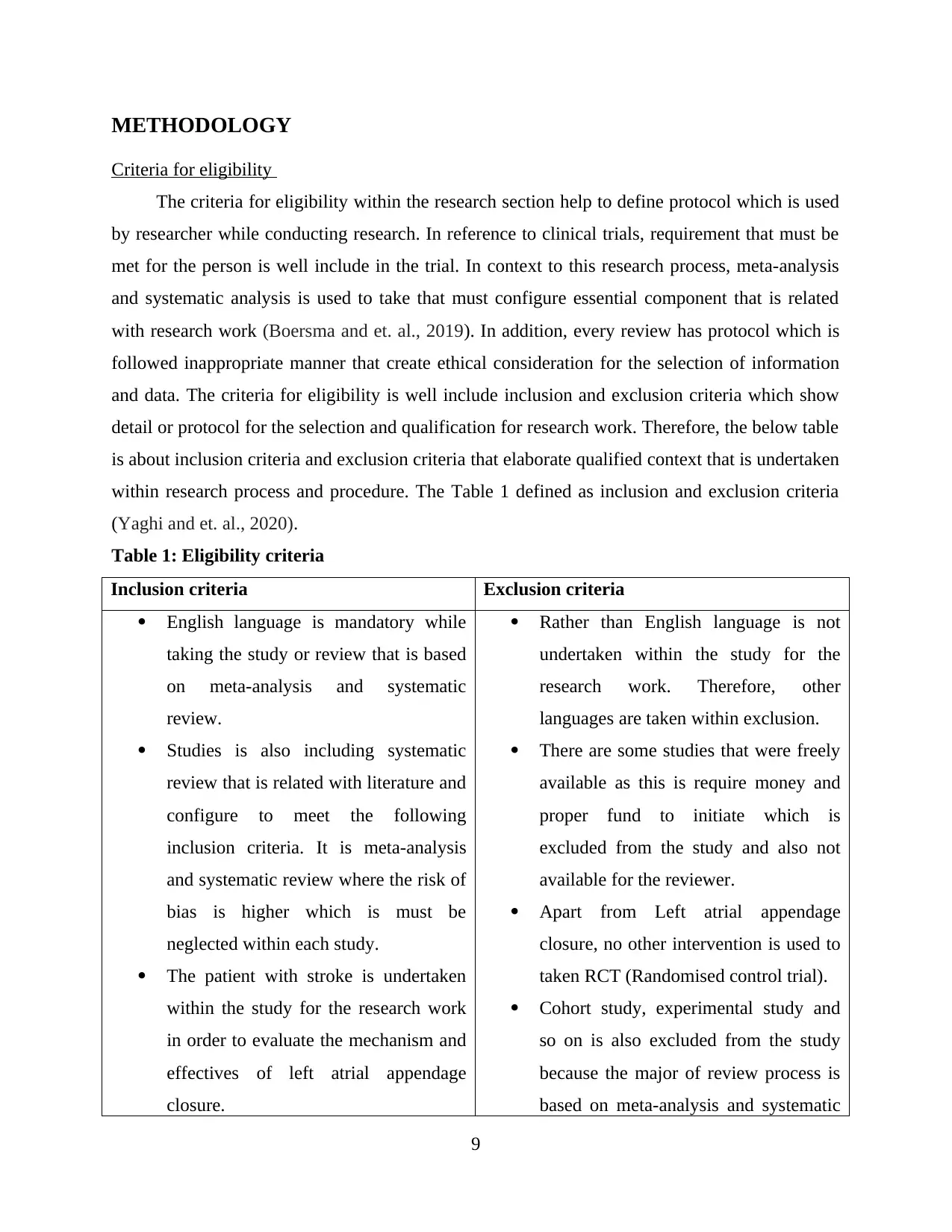
METHODOLOGY
Criteria for eligibility
The criteria for eligibility within the research section help to define protocol which is used
by researcher while conducting research. In reference to clinical trials, requirement that must be
met for the person is well include in the trial. In context to this research process, meta-analysis
and systematic analysis is used to take that must configure essential component that is related
with research work (Boersma and et. al., 2019). In addition, every review has protocol which is
followed inappropriate manner that create ethical consideration for the selection of information
and data. The criteria for eligibility is well include inclusion and exclusion criteria which show
detail or protocol for the selection and qualification for research work. Therefore, the below table
is about inclusion criteria and exclusion criteria that elaborate qualified context that is undertaken
within research process and procedure. The Table 1 defined as inclusion and exclusion criteria
(Yaghi and et. al., 2020).
Table 1: Eligibility criteria
Inclusion criteria Exclusion criteria
English language is mandatory while
taking the study or review that is based
on meta-analysis and systematic
review.
Studies is also including systematic
review that is related with literature and
configure to meet the following
inclusion criteria. It is meta-analysis
and systematic review where the risk of
bias is higher which is must be
neglected within each study.
The patient with stroke is undertaken
within the study for the research work
in order to evaluate the mechanism and
effectives of left atrial appendage
closure.
Rather than English language is not
undertaken within the study for the
research work. Therefore, other
languages are taken within exclusion.
There are some studies that were freely
available as this is require money and
proper fund to initiate which is
excluded from the study and also not
available for the reviewer.
Apart from Left atrial appendage
closure, no other intervention is used to
taken RCT (Randomised control trial).
Cohort study, experimental study and
so on is also excluded from the study
because the major of review process is
based on meta-analysis and systematic
9
Criteria for eligibility
The criteria for eligibility within the research section help to define protocol which is used
by researcher while conducting research. In reference to clinical trials, requirement that must be
met for the person is well include in the trial. In context to this research process, meta-analysis
and systematic analysis is used to take that must configure essential component that is related
with research work (Boersma and et. al., 2019). In addition, every review has protocol which is
followed inappropriate manner that create ethical consideration for the selection of information
and data. The criteria for eligibility is well include inclusion and exclusion criteria which show
detail or protocol for the selection and qualification for research work. Therefore, the below table
is about inclusion criteria and exclusion criteria that elaborate qualified context that is undertaken
within research process and procedure. The Table 1 defined as inclusion and exclusion criteria
(Yaghi and et. al., 2020).
Table 1: Eligibility criteria
Inclusion criteria Exclusion criteria
English language is mandatory while
taking the study or review that is based
on meta-analysis and systematic
review.
Studies is also including systematic
review that is related with literature and
configure to meet the following
inclusion criteria. It is meta-analysis
and systematic review where the risk of
bias is higher which is must be
neglected within each study.
The patient with stroke is undertaken
within the study for the research work
in order to evaluate the mechanism and
effectives of left atrial appendage
closure.
Rather than English language is not
undertaken within the study for the
research work. Therefore, other
languages are taken within exclusion.
There are some studies that were freely
available as this is require money and
proper fund to initiate which is
excluded from the study and also not
available for the reviewer.
Apart from Left atrial appendage
closure, no other intervention is used to
taken RCT (Randomised control trial).
Cohort study, experimental study and
so on is also excluded from the study
because the major of review process is
based on meta-analysis and systematic
9
⊘ This is a preview!⊘
Do you want full access?
Subscribe today to unlock all pages.

Trusted by 1+ million students worldwide
1 out of 40
Your All-in-One AI-Powered Toolkit for Academic Success.
+13062052269
info@desklib.com
Available 24*7 on WhatsApp / Email
![[object Object]](/_next/static/media/star-bottom.7253800d.svg)
Unlock your academic potential
Copyright © 2020–2025 A2Z Services. All Rights Reserved. Developed and managed by ZUCOL.

